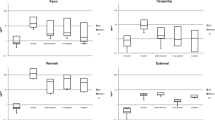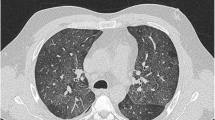Summary
A multidisciplinary cross-sectional study was carried out in 105 spray painters with long-term solvent exposure (10–44 years) and in 58 control subjects not exposed to solvents. By means of air monitoring the solvent concentrations in the ambient air during spray painting were determined using charcoal and silicagel tubes with pumps and passive samplers. In general, the air concentrations of the individual compounds did not exceed the current limit values (MAK values). Aromatic hydrocarbons like toluene, xylene, ethylbenzene, trimethylbenzene, aliphatic hydrocarbons (e.g., heptane) and acetates (ethylacetate, butylacetate) were determined to be important components of paint solvents. However, in unfavorable work conditions the “exposure index” could exceed the permissible limits two or three times. To assess the body solvent load at the time of examination, biological monitoring (BM) was performed. The main finding was that there was no evidence of neuro-toxicologically relevant solvent exposure. Only in the case of methyl hippuric acid in urine spot samples did the spray painters show a higher mean value (80 mg/l) than control subjects (below 20 mg/l), indicating recent xylene exposure. Elevated urinary chromium concentrations (maximum value 29 μg/l) were found in 28 spray painters as a result of using zinc chromate-containing wash primers without taking protective measures. To assess the degree of past solvent exposure a special questionnaire was used. This included variables like duration and amount of solvent exposure, the presence of a technical ventilation system, health complaints during painting, etc. Additionally, three “solvent exposure indices” (SEI) were calculated and used for evaluation of “dose-effect relationships.” In summary, the responses to the questionnaire did not show a characteristic pattern of symptoms. The frequency of symptoms is more likely to be determined by age than by chronic solvent exposure. Health complaints like increased tiredness, deterioration in short-term memory, and headache were equally frequent in spray painters and controls. In correlation analyses no hints of a dose-response relationship could be found.
Similar content being viewed by others
References
Angerer J, Schaller KH (eds) (1985/88/91) Analyses of hazardous substances in biological materials, vol 3. VCH, Weinheim
Arlien-Søberg P, Bruhn P, Gyldensted C, Melgaard B (1979) Chronic painters syndrome. Chronic toxic encephalopathy in house painters. Acta Neurol Scand 60:149–156
Arlien-Søberg P, Hansen L, Ladefoget O, Simonsen L (1992). Report on a Conference on Organic Solvents and the Nervous System. Neurotoxicol Teratol 14:81–82
Baelum J, Anerson I, Molhave L (1982) Acute and subacute symptoms among workers in the printing industry. Br J Ind Med 39:70–75
Baker EL, Letz RE, Eisen EA, Pothier LJ, Plantamura DL, Larson BAM, Wolford R (1988) Neurobehavioral effects of solvents in construction painters. J Occup Med 30:116–123
Bolla KI, Schwartz BS, Agnew J, Ford PD, Bleecker ML (1990) Subclinical neuropsychiatric effects of chronic low-level solvent exposure in US paint manufacturers. J Occup Med 32:671–677
Bowler RM, Mergler D, Huel G, Harrison R, Cone J (1991) Neuropsychological impairment among former microelectronics workers. Neurotoxicology 12:87–104
Brackbill RM, Maizlish N, Fischbach T (1990) Risk of neuropsychiatric disability among painters in the United States. Scand J Work Environ Health 16:182–188
Bunge W, Ehrlicher H, Kimmerle G (1978) Arbeitsmedizinische Aspekte der Verarbeitung von Lacksystemen im Spritzverfahren. (Zentralblatt für Arbeitsmedizin, Arbeitsschutz und Prophylaxe, vol 4. Fischer, Heidelberg
Cherry N, Hutchings H, Pace T, Waldron HA (1985) Neurobehavioral effects of repeated occupational exposure to toluene and paint solvents. Br J Ind Med 42:291–300
Cranach M von (1983) Standardisiertes Verfahren zur Erhebung des Psychopathologischen Befundes — Present State Examination. Beltz, Test, Weinheim
Cranmer JM, Golberg L (eds) (1986) Proceedings of the Workshop on Neurobehavioral Effects of Solvents. Neurotoxicology 7:1–190
Deutsche Forschungsgemeinschaft (DFG) (1992) Maximale Arbeitsplatzkonzentrationen und Biologische Arbeitsstoff-Toleranz-Werte 1992. VCH, Weinheim
De Rosa E, Bartolucci GB, Brighenti F, Gori GP, Sigon M, Toffolo D (1985) The industrial use of solvents and risk of neurotoxicity. Ann Occup Hyg 29:391–397
Elofsson ST, Gamberale F, Hindmarsh T, Iregren A, Isaksson A, Johnsson I, Knave B, Lydahl E, Mindus P, Persson HE, Philipson B, Stery M, Struwe G, Södermann E, Wennberg A, Wilden L (1980) Exposure to organic solvents. Scand J Work Environ 6:239–273
Fuchs A, Lüdersdorf R, Fuchs GHP, Schäcke G (1986) Bestimmung der äußeren und inneren Belastung durch organische Lösemittel bei Spritzen und Lackieren und Heizkörpern. Bericht über die 26. Jahrestagung der Deutschen Gesellschaft für Arbeitsmedizin e. V. Gentner, Stuttgart
Gilioli R, Cassitto MG, Camerino D, Colombi A, Zocchetti C (1990) Epidemiological Study of Neurobehavioural Effects of Long-Term Low-Level Exposure to Organic Solvents, 23rd International Congress on Occupational Health, Montreal, Canada, 22–28 September 1990
Gregersen P, Angelso B, Nielsen TE, Norgaard B, Udal C (1984) Neurotoxic effects of organic solvents in exposed workers: an occupational, neuropsychological and neurological investigation. Am J Ind Med 5:201–225
Hänninen H (1988) The psychological performance profile in occupational intoxications. Neurotoxicol Teratol 10:485–488
Hein HO, Suadicani P, Gyntelberg F (1990) Mixed solvent exposure and cerebral symptoms among active and retired workers. An epidemiological investigation of 3387 men aged 53–75 years. Acta Neurol Scand 81:97–102
Henschler D, Lehnert G (eds) (1990) Biologische Arbeitsstoff-Toleranz-Werte (BAT-Werte). Arbeitsmedizinisch-toxikologische Begründungen. VCH, Weinheim
Hogstedt C, Hane MD, Axelson O (1980) Diagnostic and health care aspects of workers exposed to solvents. In: Zenz C (ed) Developments in occupational medicine. Year Book Publishers, Chicago, pp 249–257
Kessel R, Römmelt H, Pfaller A, Herrmann N, Dorner HH (1985) Untersuchungen zur chronischen beruflichen Exposition gegenüber Lösemitteln in modernen Lackierstraßen der Autoindustrie. Bericht über die 25. Jahrestagung der Deutschen Gesellschaft für Arbeitsmedizin e. V. Gentner, Stuttgart
Knecht U, Weber L, Woitowitz HJ (1982) Air Monitoring in Spritzlackierbetrieben: Probleme komplexer Schadstoffgemische. Arbeitsmed Sozialmed Präventivmed 17:252–255
Maizlish NA, Langold GD, Whitehead LW, Fine LJ, Albers JW, Goldberg J, Smith P (1985) Behavioural evaluation of workers exposed to mixtures of organic solvents. Br J Ind Med 42:579–590
Maizlish NA, Fine LJ, Albers JW, Whitehead L, Langolf GD (1987) A neurological evaluation of workers exposed to mixtures of organic solvents. Br J Ind Med 44:14–25
Morrow LA, Ryan CM, Hodgson MJ, Robin N (1990) Alterations in cognitive and psychological functioning after organic solvent exposure. J Occup Med 32:444–450
Ng TP, Ong SG, Lam WK, Jones GM (1990) Neurobehavioural effects of industrial mixed solvent exposure in Chinese printing and paint workers. Neurotoxicol Teratol 12:661–664
O'Flynn RR, Monkman SM, Waldron HA (1987) Organic solvents and presenile dementia: a case referent study using death certificates. Br J Ind Med 44:259–262
Parkinson DK, Bromet EJ, Cohen S, Dunn LO, Dew MA, Ryan C, Schwartz JE (1990) Health effects of long-term solvent exposure among women in blue-collar occupations. Am J Ind Med 17:661–675
Struwe G, Wennberg A (1983) Psychiatric and neurological symptoms in workers occupationally exposed to organic solvents — results of a differential epidemiological study. Acta Psychiatr Scand [Suppl 67] 303:68–80
Triebig G, Claus DI, Csuzda I, Druschky KF, Holler P, Kinzel W, Lehrl S, Reichwein P, Weidenhammer W, Weitbrecht WU, Weltle D, Schaller KH, Valentin H (1988) Cross-sectional epidemiological study on neurotoxicity of solvents in paints and lacquers. Int Arch Occup Environ Health 60:233–241
Valciukas JA, Lilis R, Singer RM, Glickman L, Nicholson WJ (1985) Neurobehavioral changes among shipyard painters exposed to solvents. Arch Environ Health 40:47–52
Van Vliet C, Swaen GMH, Slangen JJM, de Boorder T, Sturmans F (1987) The organic solvent syndrome. Int Arch Occup Environ Health 59:493–501
Wing JK, Cooper JE, Sartorius N (1974) Present state examination (PSE), 9th edn. Medical Research Council/Cambridge University Press, Cambridge
World Health Organization (1985) Chronic effects of organic solvents on the central nervous system and diagnostic criteria. WHO Nordic Council of Ministers Working Group, Copenhagen
World Health Organization (1989) Chronic effects of organic solvents on the central nervous system — Development of core protocol for International Collaborative Study, Copenhagen
Author information
Authors and Affiliations
Rights and permissions
About this article
Cite this article
Triebig, G., Schaller, K.H. & Weltle, D. Neurotoxicity of solvent mixtures in spray painters. Int. Arch Occup Environ Heath 64, 353–359 (1992). https://doi.org/10.1007/BF00379546
Received:
Accepted:
Issue Date:
DOI: https://doi.org/10.1007/BF00379546




